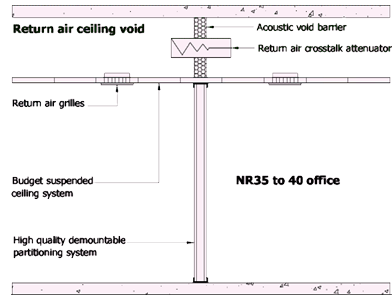Office acoustic privacy using good designs
Office Acoustic Privacy
Office acoustic privacy is the isolation of normal or raised speech produced in one room from possible listeners in another room.
Speech Intelligibility
On the other hand, speech intelligibility is the opposite of privacy. It is a function of reverberation time and background noise.
A long reverberation time in a room will cause syllables to be prolonged hence they will overlap and degrade the intelligibility of what is being said.
Furthermore, in reverberant rooms people tend to increase the volume of their voice to compensate for the increased noise level so that they will be heard over the reverberant noise.
Background Noise
BS EN ISO 11690:1997 recommends the following values of background noise levels in different office environments:
- Conference rooms – LAeq 30dB to 35dB
- Individual Office – LAeq 30dB to 40dB
- Open plan offices – LAeq 35dB to 45dB
In a conference room as the distance between the speaker and listener increases the internal ambient noise levels should be even lower than those stated above.
Internal Ambient Noise
BS 8233:1999 defines this a “pervasive noise in a given situation at a given time, usually composed of noise from many sources, inside and outside the building, but excluding noise from activities of the occupants”.
Sound Insulation
Office often suffer from inadequate sound insulation which gives rise to complaints from staff who require privacy for telephone conversations and interviews.
Privacy between offices and occupied spaces requires not only good sound insulation but also moderate background noise to mask intruding speech.
Generally for cellular offices the minimum acceptable sound insulation value is in the region of Dw38dB.
Where privacy is important this rises to around Dw48dB and even then voices are likely to be heard but not usually understood.
If the indoor ambient noise level is particularly low it may well be necessary to design to a higher sound insulation value.
As a very general rule, speech will be audible but not intelligible if Dw+LA>75, where Dw is the weighted sound level difference between rooms and LA is the indoor ambient noise level in the room.
It should be noted that if standard demountable and/or glass partitions are used to form a cellular office then it is highly likely that the sound insulation will be lower than is desirable for good privacy.
Because they are usually lightweight, and often have gaps around the perimeters, the sound insulation of prefabricated office partitions usually sits between the range of Rw30dB to Rw40dB, very occasionally, and if installed carefully with great attention to details, it can extend up to Rw45dB.
Folding/Sliding Partitions
These will only generally provide around Rw30dB.
Open Plan Offices
The maximum noise reduction that can be expected between screened work stations 2-3m apart is in the region of 15dB to 25dB. This may be adequate for general needs when the background noise is taken into account.
Ideally acoustically absorbent screens should be used with a height of at least 1.5-1.8m.
Ceilings should be low and not exceed about 3m and should be highly absorbent with an Aw of at least 0.90. The ideal floor covering would be carpet.
Open plan offices usually require good privacy as opposed to speech intelligibility. NR40 background noise levels will help mask conversation and a reverberation time of 0.5 to 0.8 seconds should be designed for.
Common Noise leakage Paths
In many many cases the acoustic issues in office settings are as follows:
- lightweight panels above doors
- lack of seals around doors
- hard reflective surfaces
- air leaks, cracks, holes and gaps
- suspended ceilings
- shared ventilation
- electrical services
- overall partition performance
Shared Ventilation
This, and a lack of acoustic void barrier, are all to common situations.
A lightweight T-grid suspended ceiling with big shared void above is extremely problematic.
Even if there is an acoustic barrier above, a shared ventilation duct, with no silencer, will allow speech to easily move between adjacent rooms.

Meeting Rooms
These should generally have a reverberation time between 0.5 and 0.8 seconds, a low background noise level of NR25, a reinforcing reflection from a ceiling section between the speaker and listener positions and sufficient acoustic absorption to ensure that there are no flutter echoes or late reflections.
This is extremely important when the room is used for video conferencing.
Adjacent Offices
The standard of privacy between adjacent offices is a product of the combination of the sound insulation between the space and the background noise level.
To maintain the same level of office acoustic privacy between rooms the sound insulation value of the partitions must increase as the background noise decreases.
Criteria
Intelligible speech = Low rating = Dw+NR below 74dB.
Between intelligible and unintelligible speech = Medium rating = Dw+NR 75 to 80dB.
Unintelligible speech = High rating = Dw+NR 80 to 90dB.
Inaudible speech = Very high rating = Dw+NR above 90dB.
